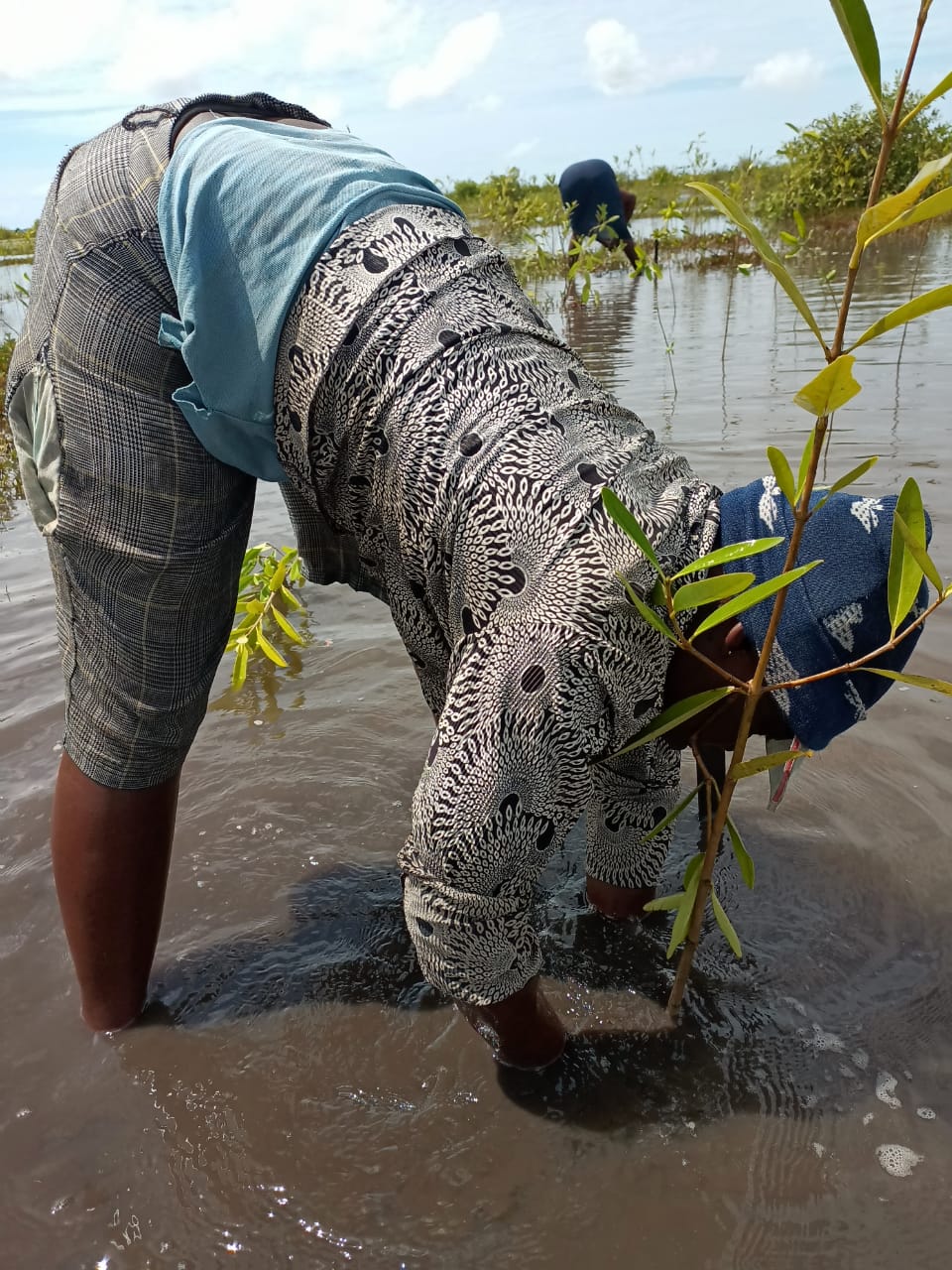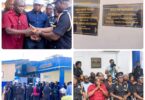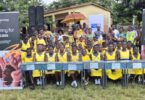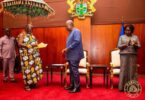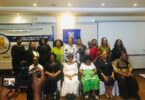There is no better way to build resilience against climate change than to restore mangroves and give back the “life” that once existed in a coastal area of Ghana.
A locally-led adaptation project by the indigenous community of Fiaxor, a fishing community in the Anlo District of Ghana’s Volta region, is an example of how communities can champion a cause in their quest to fight climate-driven threats to farmland, buildings and other essential assets.
Fiaxor, one of the six settlements in the Anlo Kome area, is located along the Keta lagoon and home to 36 original settlements in the Anlo area. The land to the south and east is surrounded by the Keys Lagoon. To the west lies the community of Kodzi and to the north the community of Alakpe.
Fiaxor covers an area of about 10 square kilometers and is home to about 900 people.
Keteklebi, as it was formerly called, was once a thick forest island and fishing in the Keta Lagoon is economic lifeblood of communities like Fiaxor nestled around the lagoon perimeter.
When the lagoon dries up, it is “chaos”, residents say. When it is over flooded, they say it is also “chaos”.
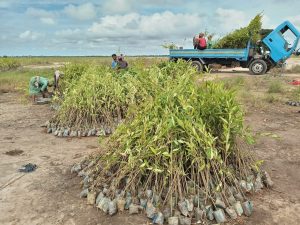
Mangrove seedlings ready for replanting@ Fiaxor Mangrove Restoration project
The area is part of Ghana’s coastal savanna where the climate is semi-arid and annual rainfall is about 80 cm and the distribution is bimodal. Major rains fall between April and June and the minor rainy season is between September and October.
The savanna-type vegetation is scattered with forbs and shrubs. The soil has a high saline content as the goon beds and margins are subject to periodic flooding by saltwater from the Volta River estuary.
This community-led adaptation project is supported by Seawater Solutions, a U.K.-based international organization through it’s local representative, Seawater Solutions Ghana that seeks to partner with communities in coastal areas to restore mangroves that have lost to commercial activity as a way to build communities’ resilience against the impacts of climate change.
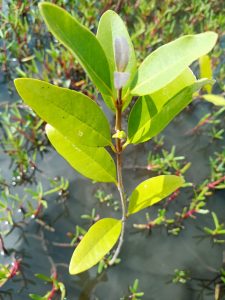
Mangrove Restoration project @Fiaxor, located in the Volta Region of Ghana
Seawater Solutions Ghana provides mangrove seedlings to the communities who take over the growing and nursing of the mangroves, giving residents ownership of the project as a way of ensuring its success.
Mangrove restoration projects aim to regenerate mangrove forest ecosystems in coastal areas where they previously existed. Restoration practices are grounded in the discipline of restoration ecology, which aims to assist the recovery of resilience and adaptive capacity of ecosystems that have been degraded, damaged or destroyed.
COMMUNITY ENGAGEMENT
Community members interviewed for this story expressed their joy and excitement at being part of the locally-led mangrove restoration project.
Madam Monica Munyo said the community – which had previously cut down mangroves for commercial use – now understood the need and importance of preserving and restoring mangroves to protect the community and farmland from extreme weather, floods and rising tides made worse by climate change.
The community collectively embraced the restoration of mangroves two years ago and agreed to accept initial support from Seawater Solutions Ghana.
“The education and advocacy by Seawater Solutions Ghana made us realize the urgency of mangrove restoration and own the project to make it a reality and a success. I can say it has been a learning process,” Munyo said.
Another resident, Mrs. Rosemary Akpalu, said she believed “the mangrove restoration would bring back the serene and beautiful ecosystem we used to have some years ago.” She said it underlined the importance of restoring lost mangroves in degraded wetlands within the community.
“This project is about local resilience to climate change and we are grateful to Seawater Solutions Ghana for engaging us and allowing us to be co-owners of the project,” Akpalu said, adding that project had also given the community an alternative source of income.
Community elders were also full of praise and appreciation for the restoration project.
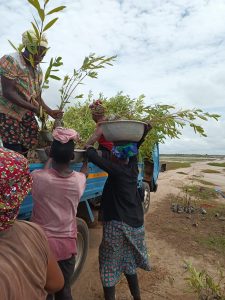
Community members (women) offloading the mangrove seedlings to the project site
Mr. Michael Kwabla Djirakor, an elder who opened his land to mangrove restoration, recounted how the degradation of his land had affected their livelihood as well as the development of the community. He looked forward to the restoration of an ecosystem that they had enjoyed in years past.
Djirakor, speaking for community’s landowners, said at first most of them were reluctant to give their lands to the project, but they later agreed after an engagement campaign that educated and sensitized landowners on the importance of mangroves and paved the way for the project to begin.
“We do not regret giving our lands to Seawater Solutions Ghana to embark on the project. This is a project we are proud of because, indirectly, we are the owners and see to the day to day of growth (of the mangroves), with support from Seawater Solutions Ghana.” he said.
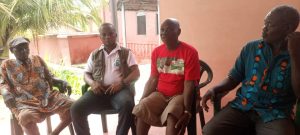
Community elders with Country Director of Seawater Solutions Ghana ( in white shirt with a jacket)
“We saw this project as way for us to restore our degraded lands to fertile lands and support our livelihoods, as well as preserve our heritage and culture by protecting our community from seawater erosion and other harsh climate issues,” Djirakor said.
Seawater Solutions Ghana decided to partner with Fiaxor and initiate a local restoration project because mangroves had been a key part of the community and the project would provide socio-economic benefits to the indigenous residents, said Mr. Raphael Ahiakpe, Country Director, Seawater Solutions Ghana.
However, the project faced several challenges in its course of implementation.
“The land was not all integrated, but highly solemnize these days that, what used to be a resource for the community people was no longer beneficial to them,” he said.
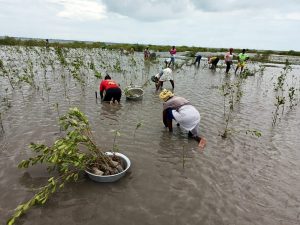
Community members (women) busily replanting the mangrove seedlings at the project site
Seawater Solutions Ghana understands the need to not only bring the mangroves back to life, but “our focus is also to see how best we can bring back livelihood alternatives for our people,” Ahiakpe said.
The project was designed to adhere to U.N. Sustainable Development Goals (SDGs), including a goal to alleviate poverty.
“Our effort is to make sure that the people are the real beneficiaries of whatever we are doing. We are solely focused on the community. So, our approach is a creamer model, which is based on the communities’ full participation in what we’re doing,” Ahiakpe said.
“People that are very conversant with restoration efforts know that if you’re running restoration initiatives and they are not people centered, you’re likely to fail. So, our main interest is to make sure that the people in these communities that we’re working with are fully participatory and are the real beneficiaries of whatever outcome that we’re getting from our operations,” he added.
In the southern Ghana, there are three main species of mangoes that are very common, including red and white mangroves. Seawater Solutions Ghana is solely focused on the three species of mangroves for restoration activities.
SOCIO-ECONOMIC BENEFITS
When asked about the socio-economic benefits of the project, community members said they earn an income whenever they are engaged by Seawater Solutions Ghana to plant the mangrove seedlings in wetlands identified for restoration.
The alternative source of income comes as a relief to many residents who depend mostly on fishing. It has been less lucrative due to lower catches linked to the impacts of climate change.
“Women and men go fishing and they don’t catch anything because areas that support the life of these fishes no longer exist,” Ahiakpe said.
The restoration of mangroves will not only help communities to build their resilience against the impacts of climate change, but also support their livelihoods by restoring fish ecosystems.
“The people, first of all, need a livelihood source. So, when you go they will ask you, what is the benefit of what you’re coming to do for us? We need livelihood sources, they say”, Ahiakpe said.
But the lagoon, which used to be their main heaven of fish products that they get their daily bread from, is no longer producing or productive. Fish breeding areas have ben degraded and destroyed by human activity.
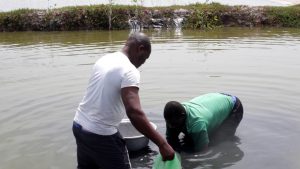
A fish pond created by Seawater Solutions Ghana to serve as an alternative source of income for Fiaxor Community
The wages for planting mangrove seedlings is a short-term initiative but not a long-term goal for Seawater Solutions Ghana. “The wages we pay them are for when they join our team to plan and support us. But that is not a long-term target for us. The long-term target is that, if we’re able to establish the mangroves, first of all, is going to restore the productivity in the coastal open lagoon itself,” Ahiakpe said.
He noted the mangroves serve as nursing areas for the remnant species that are still in the open lagoon. “That is where they’re going to breed, that’s where they’re going to grow up, so the aim now is to get the breeding areas restored,” he added.
“We are also introducing what we call sustainable aquaculture…a regenerative system where we don’t focus on conventional agriculture that degrade ecosystems. We try to mimic what is happening in this ecosystem by integrating mangroves into smallholder farms where the families who take ownership of those farms can survive when they cannot get to the open lagoon,” Ahiakpe said.
“We want to be a source of livelihood for them in terms of fish production and the other aspects of our alternatives in terms of livelihood is to train some of them in beekeeping,” he added.
Research shows that mangroves help the production of honey and would be a good source of income for community members.
Dr. Daniel Tutu Benefoh, the National Focal Point to the UNFCCC, said these types of climate resilience projects can become alternative livelihood sources, especially when climate change has impacted a community’s primary livelihoods.
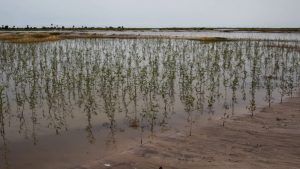
Replanted Mangrove seedlings at Fiaxor under the Mangrove Restoration project
He said such projects can help fish species to recover and eventually return to being a source of income. Dr. Benefoh urged communities, especially those in the coastal belt, to embrace projects that aim to build resilience against climate change.
ROLE OF GOVERNMENTS & CSOs
The role of Civil Society Organizations (CSOs) can’t be overlooked in the nation’s quest to safeguard the lives and properties of communities in coastal areas that face climate-driven sea level rise and sea water erosion, among others.
Benefoh said CSO roles should be strengthened and supported if the Sustainable Development Goals (SDGs) are to achieved by 2030. Also, CSOs have a crucial role to play in support of mangrove restoration projects that allow for active participation and involvement of community members, which gives them a sense of ownership of the initiative.
“Such projects are bound to fail when CSOs don’t engage the indigenous members of these communities”, he said in calling for effective and efficient collaboration between CSOs and communities in restoration projects.
The government and agencies such as the Forestry Commission, the District and Municipal Assemblies should identify restoration projects within their jurisdictions and support the efforts of CSOs and communities as an acknowledgment of their relevance in the country’s fight against climate change related issues.
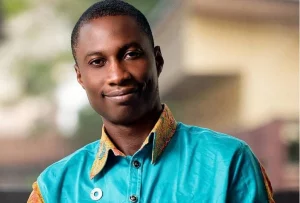
Executive Coordinator for Strategic Youth Network for Development (SYND), Mr. Chibeze Ezekiel
Executive Coordinator for Strategic Youth Network for Development, Mr. Chibeze Ezekiel, called on his fellow colleagues to tailor projects that would seek the best interest and wellbeing of the communities as they operate especially projects that would restore the degraded lands of coastal communities.
“We are the direct ‘agencies’ that engage such communities and ascertain their needs and wants. It is important to put forward projects that are community centered and provide relief in regards to difficulties,” he said.
PROJECT SUSTAINABILITY
To ensure the sustainability of mangrove restoration efforts in the Fiaxor community, the elders hinted at the use of fines to deter the community from destroying mangroves and cutting down of them when they become trees. They would also form a watch dog team that would oversee the mangrove restoration project.
“If the need arises, we would increase the fine of 300 cedis to 500 cedis for them to fear the cost” of damaging mangroves, said Mr. Geshon Kofi Adzogblo.
For Seawater Solutions Ghana, the establishment and management of community woodlands is one immediate action, aside the education campaign, to make sure residents understand the benefits of the mangrove restoration.
“When there is a woodland system where the community can cut down the trees to support their immediate needs, the mangroves would be allowed to serve its purpose”, Ahiakpe said.
The community, in partnership with Seawater Solutions Ghana, have agreed to set up a woodland system as an alternative source of firewood for personal and commercial purposes to support livelihoods and protect mangrove restoration efforts.
THE WAY FORWARD
Looking to the future, Seawater Solutions Ghana’ Ahiakpe said there have been numerous challenges since the locally-led mangrove restoration project began, but he quickly added: “With our resilience last year when we started in 2021, we did a prototype trial of about 45,000 White mangrove seedlings planted. We have been able to get about 50% of them survived. And it’s not totally a bad situation because we’ve learned a lot of lessons from it.”
In 2022 the prototype trial has planted nearly 1,000 seedlings, with an impressive 90% survival rate.
“And our mission here will be a success if we have the resources and all the necessary support to get that done,” the country director said.
Talking about necessary support, Ahiakpe was grateful and appreciative to the first community for their warm reception and owning the mangrove restoration project. This he attributed to the numerous education and workshops on why it is needed to restore the ecosystem that had been destroyed.
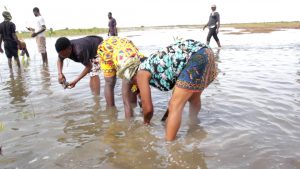
Community members replanting mangrove seedlings at the Restoration site
“Many members understood and realized that this initiative that we’re embarking on is indirectly to their benefit, so the community embraced it wholeheartedly, and I think so far so good,” he said.
Community engagement in mangrove restoration is of great importance in the fight against climate change, said the National Focal Point to the UNFCCC, Benefoh.
“When communities take the lead in such a project, the success rate is high and the purpose is achieved. The building of local resilience to climate change needs to be encouraged, especially in coastal areas across the country,” he said.
It’s also time for government to partner with communities to drive such projects with the aim of restoring ecosystems and boosting the socio-economic livelihoods of affected communities, he said.
If there is an alternative source of livelihood, the mangrove trees would not be cut down for commercial purposes and degrade ecosystems. There is a need for future restoration projects to be led by communities and give them ownership of projects that directly affect their livelihoods.
SYND’s Chibeze said he strongly believes that local resilience against climate change is the best and surest way to protect communities in coastal areas.
The need for communities to preserve their livelihoods, properties and culture means embracing such projects as their own to ensure they are sustainable and successful, he said.
Article written by Ishmael Barfi Gyebi Boateng
This story was written and produced as part of a media skills development programme delivered by Thomson Reuters Foundation. The content is the sole responsibility of the author and the publisher.
Source: www.thenewindependentonline.com


